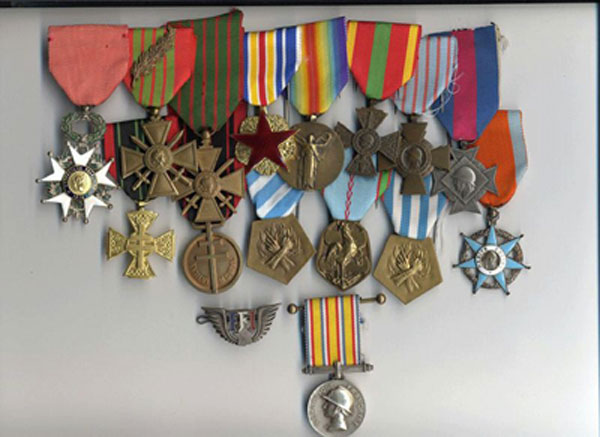-
Posts
2,284 -
Joined
-
Last visited
-
Days Won
6
Content Type
Profiles
Forums
Blogs
Gallery
Events
Store
Posts posted by PKeating
-
-
Three Vichy-issue Croix de Guerre. The riband of the one of the left was supressed and replaced by the more common green and black riband seen on the right. Bearing the dates 1939-1940 on the reverse, these crosses were given to French veterans of the 1939-40 War who had earned the Croix de Guerre in exchange for their Republican versions, who enlisted in one of the Vichy or collaborationist forces on whose uniforms French medals could be worn. These organisations included the Vichy armed forces, paramilitary forces like the Milice, the police and other groups, including the paramilitary veterans' associations.
However, the real rarity here is the one in the middle, instituted in March 1944. Only members of the Premier R?giment de France and P?tain's personal bodyguard were eligible for this cross, which bears the Vichy Francisque symbol and the legend "Etat Fran?ais" on the central medallion and the date 1944 on the reverse. Less than 200 are believed to have been awarded. This cross is as rare as the LVF cross and is really the only 'proper', traditional Croix de Guerre instituted by Vichy France. It was awarded principally for actions against the Resistance and enemy forces like the SAS and OSS, although I did hear of one awarded to a man who saved a comrade's life during an Allied strafing attack.
PK

 0
0 -
Nice selection of French medals. They're one of my passions too. This group was, believe it or not, all to one man. He survived WW1, the 1939/40 War, the Resistance and Buchenwald. I have his miniatures too.
PK

 0
0 -
The FJR1 cuff title in the image posted by Jacques was in my collection and has also been featured in a couple of books. It is a textbook NCO's cuff title. I would post detailed images but cannot get them under the size limit for new members without making them so small as to be pointless. In any case, the cuff title about which my fellow member was asking purports to be an officer's type but I regret to tell the gentleman that it doesn't resemble any original officer's quality FJR1 cuff title I have ever seen. The regiment did commission some cuff titles during their brief time in Holland after the Moerdijk and Waalhaven operations but this is not one of those. I would give it a miss if I were you and wait for a well-documented, textbook example to happen along. They do come on the market occasionally but you have to be very quick off the mark!
PK
0 -
Hallo Wayne,
The Type 3 Army Para Badge, in other words, the 1943/44 feinzink issue, is as rare as the prewar Type 2 aluminium badge. They were struck on the same dies by C E Juncker. There are a few examples of genuine Type 2 aluminium badges bearing the same maker's mark as that found on all of the Type 1 badges but they are very rare indeed. The same dies were used for the wreaths in 1937/38 and again in 1943/44 but there were substantial differences between the Type 1 and Type 2 badges in terms of hand-finishing. At some point, also, during Type 2 production, the wreaths were made thicker, clearly by the addition of a shim. The point is that the surface detailing imparted by the dies never changed so anything differing in this respect from known original badges by C E Juncker is highly unlikely to be genuine. The same dies were also used for the Type 2 and Type 3 diving eagles. Fakers have come quite close but never quite close enough, fortunately, so the same remarks apply. To date, there are no serious fakes of the Type 1 badge. I would illustrate my points but it is hard to get the images below the 60kb limit without losing important detail with the software I use, which is pro level Mac but here's a shot of the three basic types.
PK

 0
0




French Medals
in France
Posted · Edited by PKeating
Just to round off this evening's display, here is a unit citation to an unit of the American Field Service in France in 1918 for their gallantry in evacuating wounded from a gas-contaminated battlefield, under enemy fire. Real, classic, grim Western Front stuff. Note the name of the American commander, Appleton J Miles. I haven't finished researching this one yet but I think he was the grandson of the US Army General Nelson Appleton Miles who 'pacified' Geronimo and his warriors. Anyway, it's a rare citation.
PK